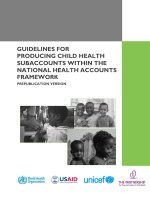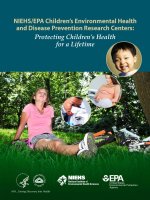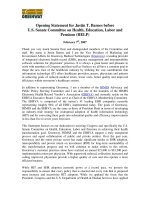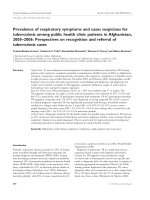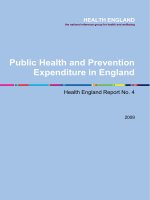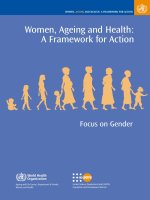Public Health Strategic Framework for COPD Prevention pptx
Bạn đang xem bản rút gọn của tài liệu. Xem và tải ngay bản đầy đủ của tài liệu tại đây (3.95 MB, 20 trang )
Public Health Strategic
Framework for
COPD Prevention
National Center for Chronic Disease Prevention and Health Promotion
Division of Adult and Community Health
Suggested Citation: Centers for Disease Control and Prevention. Public Health Strategic Framework
for COPD Prevention. Atlanta, GA: Centers for Disease Control and Prevention; 2011.
Available at www.cdc.gov/copd
Disclaimer: e ndings and conclusions in this report are those of the authors and do not necessarily
represent the ocial position of the Centers for Disease Control and Prevention.
Introduction
In the spring of 2010, the Centers for Disease Control and Prevention (CDC) and several
partners embarked on an intensive process to examine the current state of knowledge
regarding chronic obstructive pulmonary disease (COPD) prevention. e process included
identifying public health gaps and generating a set of goals that would dene the unique role
and contributions of public health in the prevention and control of COPD. is workgroup
represented other federal agencies, academia, the health care sector, national organizations, and
other COPD stakeholders. e purpose of this report is to provide a framework that could be
used by the public health community to address COPD as an important public health issue.
Background
Approximately, 12 million Americans have been diagnosed with COPD, but at least another
12 million Americans may be undiagnosed (1). COPD refers to a group of chronic diseases,
including emphysema and chronic bronchitis, that impair the ow of air in the lungs and make
breathing dicult. While COPD death rates are higher among men than women, over the
past 20 years, the number of COPD deaths among U.S. women has increased much faster than
those among men (1–3). COPD death rates are also higher among whites than among African
Americans or persons of other races (1–3), and in some states, including Idaho and Indiana
(3). In addition, women had more COPD hospitalizations than men and more emergency
department visits (1,2,4).
Prevention
Approximately 75% of COPD cases are attributed to cigarette smoking (5). Occupation-related
exposures may account for another 15% of COPD cases (6) and genetic factors, asthma,
respiratory infections, and indoor and outdoor exposures to air pollutants also play a role
(6,7). us, COPD largely can be prevented. Prevention of COPD begins with reducing and/
or eliminating smoking initiation among teenagers and young adults and encouraging tobacco
cessation among current smokers. More than 20 million workers in the United States have been
exposed to gases, vapors, fumes, and dusts that may cause COPD (6). Public health programs
and policies that focus on tobacco-use prevention and cessation, reducing occupational
exposure to dusts and chemicals, and reducing other indoor and outdoor air pollutants are
critically important. Early treatment and control of asthma may also prevent the development
of COPD.
1
Diagnosis
Common symptoms of COPD include shortness of breath, cough, phlegm, and wheezing. As
many as one-half of all persons with symptoms of COPD have not been diagnosed because
these signs are oen attributed to aging or “normal” smoker’s symptoms. A denitive diagnosis
of COPD involves measuring lung function using spirometry, which is a noninvasive outpatient
procedure.
Treatment
Once COPD has been diagnosed, goals of treatment and management include relieving
symptoms; preventing and treating disease progression, complications, and exacerbations;
improving exercise tolerance, daily activity, and health status; monitoring nutritional needs;
and reducing premature mortality (8). Management should include smoking cessation and
abstinence; limiting exposure to secondhand smoke, dusts, fumes, and gases; pharmacological
treatment with bronchodilators and corticosteroids; supplemental oxygen therapy; pulmonary
rehabilitation; collaborative self-management; and surgery (8). Clearly, eorts toward patient
and professional education should continue to focus on promoting treatment modalities for
persons with COPD as well as persons at risk for COPD.
Public Health Goals
e workgroup identied four goals that were grounded in the following public health areas:
(1) surveillance and evaluation: improve collection, analysis, dissemination, and reporting of
COPD-related public health data; (2) public health research and prevention strategies: improve
understanding of COPD development, prevention, and treatment; (3) programs and policies:
increase eective collaboration among stakeholders with COPD-related interests; and (4)
communication: heighten awareness of COPD among a broad spectrum of stakeholders and
decision makers (Table 1). To accomplish these goals, the workgroup proposed the following
objectives, strategies, and actions based on a detailed, scientic rationale.
2
Goal 1: Surveillance and Evaluation
Improve collection, analysis, dissemination, and reporting of COPD-related public health data.
Objectives
• Adapt and expand current national population-based surveillance systems such as the
Behavioral Risk Factor Surveillance System (BRFSS, state-based, self-reported data),
National Health and Nutrition Examination Survey (NHANES, national data collection
involving a combination of interviews, spirometry, and physical examinations), and the
National Health Interview Survey (NHIS, national, self-reported data) to include more
COPD-related information.
• Adapt and expand current national health care surveillance systems (health care system-
based surveys) to include COPD-related information.
• Analyze and report COPD-relevant data from these surveys.
Rationale
Ongoing data collection is required to assess the nation’s progress toward Healthy People
2020 COPD objectives which includes: (1) Reduce activity limitations among adults with
chronic obstructive pulmonary disease (COPD); (2) Reduce deaths from chronic obstructive
pulmonary disease (COPD) among adults; (3) Reduce hospitalizations for chronic obstructive
pulmonary disease (COPD); and (4) (Developmental) Increase the proportion of adults with
abnormal lung function whose underlying obstructive disease has been diagnosed. Current
population-based surveys already capture some information related to COPD such as smoking
prevalence, medical care utilization, and prevalence of chronic health conditions. However,
COPD-related topics could be analyzed more extensively in current surveillance systems and
new questions could be added to existing surveys. Due to the designs and periodic revisions
of these surveys, adapting or adding new questions related to COPD to existing surveys would
be more time- and cost-ecient than creating new surveillance systems specically focused on
COPD.
3
Strategy 1: Maximize use of currently available data.
Potential actions include:
• Analyzing currently available data relevant to COPD in existing surveys (BRFSS,
NHANES, NHIS, etc.);
• Publishing high prole CDC reports on COPD-related topics;
• Developing a comprehensive report of information (e.g., surveillance summary) across
surveys regarding COPD every 4 years;
• Presenting information on current COPD-related NHANES survey data addressing
occupational risk factors.
Strategy 2: Develop and initiate new data collection within existing surveys.
Potential actions include:
• Adding new questions related to COPD to existing surveys;
• Developing and testing new questions for reliability and validity, as needed;
• Rening the denition of COPD in existing surveillance systems by adding the
terms “COPD” and “chronic obstructive pulmonary disease” to the currently used
“emphysema” and “chronic bronchitis” terms;
• Adding new questions on occupational and environmental exposures;
• Including new queries on genetics and family history;
• Inserting new questions related to asthma;
• Promoting collaborations between federal agencies to develop and implement
standardized COPD-related questions.
4
Strategy 3: Improve the ability of federal agencies to collect, analyze, and report
health care data from electronic health records (EHR).
Potential actions include:
• SupportingthedevelopmentofuniformEHRdenitionsofCOPD;
• SupportingcollectionofclinicalmeasuresandriskfactorsforCOPDincluding
occupation,familyhistory,genetics,andsmokingaspartofEHRs;
• Developingtemplatesforcollectionofclinicaldata;
• DevelopingstandardCOPD-relatedmeasurements(i.e.,asdeterminedbythe National
CommitteeforQualityAssurance’sHealthcareEffectivenessDataandInformationSet
andtheNationalQualityForum)inEHRsfortheCentersforMedicare&Medicaid
Services,HealthResourcesandServicesAdministration,DepartmentofVeterans
Affairs,andtheU.S.DepartmentofDefense;
• Developingpartnershipswithhealthcaredeliverysystemsforpilotprojectsusing
EHRstocollectCOPDinformation(includinglargecity,smalltown,andruralpatient
populations);
• DevelopingstandardsforaccessingspirometrydatathroughEHRs;
• Developingastandardformatforreportingofspirometryresults;
• Developingandtestingquality-of-caremeasures,includingspirometry,toconrm
COPDdiagnosis.
Strategy 4: Encourage the involvement of the appropriate organizations in the
development of surveillance case denitions for COPD and to initiate COPD
surveillance.
Potential actions include:
• Developing a consensus statement with the Council of State and Territorial
Epidemiologists on surveillance case denitions;
• Developing surveillance templates for partner organizations.
5
Goal 2: Public Health Research and Prevention Strategies
Improve understanding of COPD development, prevention, and treatment.
Objective
• Support and conduct epidemiologic and applied prevention research that explores risk
factors, prevention, and treatment of COPD.
Rationale
COPD, although preventable and treatable, is not currently curable. us, the primary
prevention of COPD remains a critical action for public health. New investigations into COPD
risk factors could explore occupational hazards, environmental exposures, genetics, family
history, and co-morbid conditions such as asthma. Investigation of proper training and clinical
use of spirometry and evidence-based treatment modalities is also warranted.
Strategy 1: Conduct assessment of COPD environmental risk factors in addition
to smoking and occupational exposures.
Potential actions include:
• Conducting epidemiologic investigations to track possible environmental causes and
risk factors;
• Developing formal partnerships with the Environmental Protection Agency and other
institutions to promote research on ambient air pollution as a COPD risk factor;
• Publishing analysis for risk factors of COPD.
6
Strategy 2: Assess current health care practices, including the proper use of
spirometry, regarding the diagnosis and treatment of COPD and COPD’s
relationship to asthma and other co-morbid conditions such as cardiovascular
disease, stroke, depression, musculoskeletal disease, osteoporosis, and diabetes.
Potential actions include:
• Analyzing and publishing COPD-related health care practice and treatment data from
national health care surveys and other available data sets;
• Identifying information gaps in the areas of the diagnosis and treatment of COPD.
Strategy 3: Identify specic public health research needs for COPD prevention.
Potential actions include:
• Convening a broad-based working group of key stakeholders to identify prevention
research needs and priorities and to publish a report;
• Collaborating with public and private sector health care partners to encourage new
prevention research activities.
7
Goal 3: Programs and Policies
Increase eective collaboration among stakeholders with COPD-related interests.
Objective
• Increase prevention- and policy-related collaboration among partner organizations
interested in COPD-related concerns such as tobacco, asthma, and occupational health.
Rationale
Extensive programs for the public, health care professionals, and provider systems already
exist to prevent and treat the consequences of tobacco use. However, tobacco control programs
may not be aware of the latest statistics and treatments for specic tobacco-related illnesses,
including COPD. In turn, COPD stakeholders, practitioners, and decision makers may not
be aware of current public health eorts in tobacco control. ere are also extensive networks
of health care professionals, stakeholders, and other constituents for co-morbid diseases
and conditions of COPD such as asthma, heart disease, stroke, and diabetes. Many states
have conducted state COPD summits and formed COPD coalitions, and either have or are
developing state COPD action plans.
Strategy 1: Enhance the collaboration between tobacco control programs and
COPD-related programs at national, state, and local levels.
Potential actions include:
• Encouraging tobacco control and COPD partners’ interactions to address programmatic
and policy issues related to both smoking and COPD;
• Identifying the number of states that have COPD action plans;
• Increasing the number of states that have action plans and providing connections to state
tobacco control plans;
• Supporting collaboration between state tobacco control and COPD programs to develop
best practices and build templates for COPD action plans, including implementation
strategies;
• Establishing regular state tobacco control and COPD liaison activities;
• Conducting meetings among appropriate partners to explore opportunities for
complementary activities between tobacco control and COPD programs;
• Identifying a COPD contact for each state health department;
• Identifying speakers on relevant COPD topics for tobacco-related conferences at the
8
national and state level; likewise, identifying speakers on relevant tobacco topics for
COPD conferences.
Strategy 2: Develop a national COPD action plan.
Potential actions include:
• AnalyzingexistingstateCOPDactionplanstoidentifybestpractices;
• Conveningameetingofabroadgroupofstakeholderstodevelopanationalactionplan;
• Preparingandcirculatingthedraftactionplantorelevantagenciesandpartners;
• Publishingandinitiatingthenalactionplan;
• Supportinga reportonCOPDfromtheTaskForceonCommunityPreventiveServices.
Strategy 3: Support workplace programs and policies that reduce the risk of
COPD.
Potential actions include:
• Supporting the development of workplace policies regarding topics such as
» Indoor smoke-free policy;
» Campus (indoor/outdoor) smoke-free policy;
» Insurance coverage for evidenced-based smoking cessation treatments;
» Strong worker protection and respiratory protection programs, including
surveillance;
» Workplace indoor air quality assurance policy;
» Resources for health risk appraisals with accompanying workplace coaching and
treatment interventions;
» Resources for workplace screening programs for at-risk workers and families;
• Providing education and consultation to employers in various types of workplace
locations.
9
Goal 4: Communication
Heighten awareness of COPD in the following groups: people with COPD and their families,
people with COPD risk factors, health professionals (especially primary care providers),
provider systems, media, decision makers, policy makers, and the public.
Objective
• Improve awareness of the warning signs for COPD, the risk factors for COPD, and the
fact that COPD is preventable and treatable.
Rationale
Awareness of COPD prevention, treatment options, and the seriousness of its consequences
remains low among most Americans.
Strategy 1: Collaborate with appropriate partners to develop educational
resources for people with COPD, people with COPD risk factors, families,
health professionals (especially primary care providers), provider systems,
media, decision makers, policy makers, and the public.
Potential actions include:
• Identifying and conducting meetings with appropriate partners to develop and promote
targeted educational approaches for the audiences listed in the Communication goal;
• Identifying and evaluating existing programs;
• Preparing and pilot testing educational approaches in dierent audiences;
• Initiating education activities;
• Evaluating education activities using both process and outcome measures;
• Expanding partnerships to include additional advocates such as women’s groups, seniors,
unions, and faith-based organizations;
• Developing a phased plan to collaborate with partners on addressing the key audiences.
10
Strategy 2: Collaborate with professional health organizations to communicate
current standards of diagnosis, including spirometry use, and treatment options
for COPD.
Potential actions include:
• Assessing current educational activities and initiatives using evidence-based standards;
• Collaborating with public health and health profession partners to develop continuing
education and training activities for professional audiences, especially primary care
providers.
Conclusion
e four goals outlined in this COPD public health action plan should help with the ongoing
and future development of health initiatives to prevent and control COPD. Additionally, the
framework will increase the awareness of COPD as an important public health issue.
11
References
1. American Lung Association. Trends in COPD (emphysema and chronic bronchitis):
morbidity and mortality. February 2010. [cited 2010 Dec 30]. Available at http://www.
lungusa.org/nding-cures/our-research/trend-reports/copd-trend-report.pdf.
2. Centers for Disease Control and Prevention. Chronic obstructive pulmonary disease
surveillance—United States, 1971–2000. MMWR 2002;51(SS-6):1–16.
3. Centers for Disease Control and Prevention. Deaths from chronic obstructive pulmonary
disease—United States, 2000–2005. MMWR 2008;57(45):1229–1232.
4. Brown DW, Cro JB, Greenlund KJ, Giles WH. Trends in hospitalization with chronic
obstructive pulmonary disease—United States, 1990–2005. COPD 2010;7(1):59–62.
5. Centers for Disease Control and Prevention. Smoking-attributable mortality, years of
potential life lost and productivity losses—United States, 2000–2004. MMWR 2008;
57(45):1226–1228.
6. American oracic Society. American oracic Society statement: occupational
contribution to the burden of airway disease. Am J Respir Crit Care Med 2003;167:787–
797. [cited 2010 Dec 30]. Available at
chapter4/a4-50.pdf.
7. Centers for Disease Control and Prevention. Chronic obstructive pulmonary disease
(COPD). [cited 2010 Dec 30]. Available at:
8. National Heart, Lung, and Blood Institute. COPD Learn More Breathe Better campaign.
[cited 2010 Dec 30]. Available at
htm.
12
Table 1. Primary Goals and Strategies for the Public Health Framework for
COPD Prevention
Goal 1: Surveillance and Evaluation
Improve collection, analysis, dissemination, and reporting of COPD-related data.
Strategy 1
Maximize use of currently available data.
Strategy 2
Develop and initiate new data collection within existing surveys.
Strategy 3
Improve the ability of federal agencies to collect, analyze, and report
health care data from electronic health records.
Strategy 4
Encourage the appropriate organizations to develop surveillance case
denitions for COD and to initiate COPD surveillance.
Goal 2: Public Health Research and Prevention Strategies
Improve understanding of COPD development, prevention and treatment.
Strategy 1
Conduct assessment of COPD environmental risk factors in addition to
smoking and occupational exposures.
Strategy 2
Assess current health care practices regarding the diagnosis and
treatment of COPD and COPD’s relationship to asthma and other
co-morbid conditions such as cardiovascular disease, stroke, depression,
musculoskeletal disease, osteoporosis, and diabetes.
Strategy 3
Identify specic public health research needs for COPD prevention.
Goal 3: Programs and Policies
Increase eective collaboration among stakeholders with COPD-related interests.
Strategy 1
Enhance the collaboration between tobacco control programs and COPD-
related programs at national, state, and local levels.
Strategy 2
Develop a national COPD action plan.
Strategy 3
Support workplace programs and policies that reduce the risk of COPD.
Goal 4: Communication
Heighten awareness of COPD in the following groups: people with COPD and their families,
people with COPD risk factors, health professionals (especially primary care providers),
provider systems, media, decision makers, policy makers, and the public.
Strategy 1
Collaborate with appropriate partners to develop educational resources
for people with COPD, people with COPD risk factors, families, health
professionals, provider systems, media, decision makers, policy makers,
and the public.
Strategy 2
Collaborate with professional health organizations to communicate
current standards of diagnosis, including spirometry use, and treatment
options for COPD.
13
COPD Workgroup Meeting Participants
Paul Billings
American Lung Association
Vice President, National Policy and Advocacy
Gary Ewart
American oracic Society
Director of Government Relations
Winston Liao
NC Department of Health and Human Services
Epidemiologist
Division of Public Health, Asthma Program
Ann Malarcher, PhD, MSPH
National Center for Chronic Disease Prevention and Health Promotion
Senior Scientic Advisor
Oce on Smoking and Health
David Mannino, MD - COPD Workgroup Chair
University of Kentucky
Professor of Medicine
College of Public Health
Department of Preventive Medicine and Environmental Health
Roy Pleasants II, PharmD
Duke University School of Medicine
Associate Professor, Division of Pharmacy Practice
Pulmonary Medicine
Antonello Punturieri, MD, PhD
National Heart, Lung, and Blood Institute
Program Director
Division of Lung Diseases
Eileen Storey, MD, MPH
National Institute for Occupational Safety & Health
Acting Chief, Surveillance Branch
Division of Respiratory Disease Studies, CDC
John Walsh
Alpha-1 Foundation
David Weissman, MD
National Institute for Occupational Safety & Health
Director
Division of Respiratory Disease Studies, CDC
14
Gallery Observers
Centers for Disease Control and Prevention (CDC)
Janet Cro, PhD
Geraldine S. Perry, DrPH, RD
Letitia Presley-Cantrell, PhD, MEd
Stephanie L. Sturgis, MPH
National Institute for Occupational Safety & Health (NIOSH)
Eva Hnizdo, PhD
Casey Chosewood, MD
Alpha-1 Foundation
Miriam O’Day
Senior Director of Public Policy
Alpha-1 Foundation
COPD Learn More Breathe Better Campaign
Rosy McGillan
Porter Novelli Project Manager
15
External Reviewers
David H. Au, MD MS
Associate Professor
Pulmonary and Critical Care Medicine
University of Washington and Investigator
Health Services Research and Development
VA Puget Sound Health Care System
A. Sonia Buist, MD, PhD
Professor of Medicine, Physiology & Pharmacology
Public Health and Preventive Medicine
Division of Pulmonary and Critical Care Medicine
Oregon Health & Science University
David B. Coultas, MD
Physician in Chief/Chair Prof
Department of Medicine
University of Texas Health Science Center at Tyler
Jerry A. Krishnan, MD, PhD
Associate Professor of Medicine and Health Studies
Director, Asthma and COPD Center
Director, Refractory Obstructive Lung Disorders Clinic
University of Chicago Medical Center
Jonathan Samet, MD, MS
Professor and Flora L. ornton Chair
Department of Preventive Medicine
Keck School of Medicine
Director, Institute for Global Health
University of Southern California
Byron omashow, MD
Clinical Professor of Medicine, Division of Pulmonary, Allergy and Critical Care Medicine
Medical Director, Jo-Ann F. LeBuhn Center
Board Chairman, COPD Foundation
Columbia University, College of Physicians and Surgeons
Barbara P. Yawn, MD, MSc, FAAFP
Director of Research, Olmsted Medical Center
Adjunct Professor, Family and Community Health
University of Minnesota
16
CS220390
